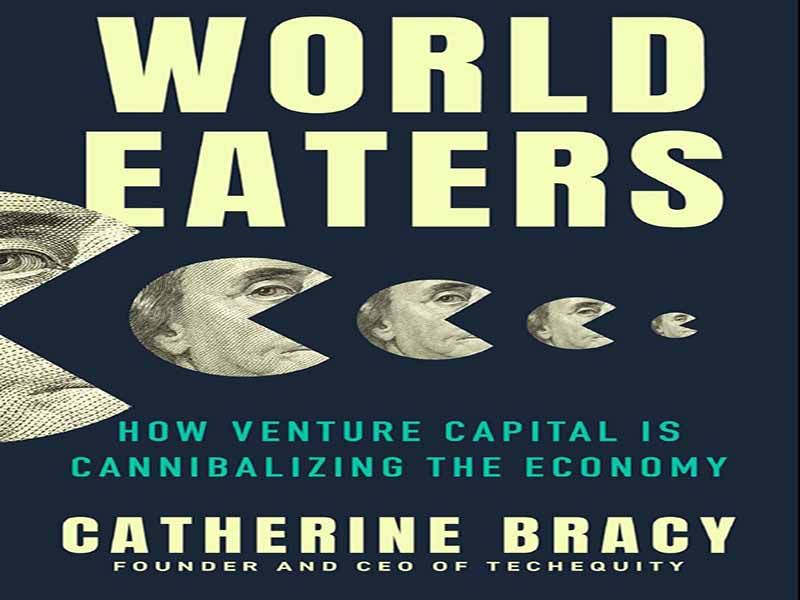- عنوان کتاب: World Eaters – How Venture Capital is Cannibalizing the Economy
- نویسنده: Catherine Bracy
- حوزه: سرمایه گذاری
- سال انتشار: 2025
- تعداد صفحه: 274
- زبان اصلی: انگلیسی
- نوع فایل: pdf
- حجم فایل: 3.00 مگابایت
تصور زمان و مکانی که همزمان خوشبینانهتر و دیستوپیاییتر از سانفرانسیسکو در نیمه اول دهه ۲۰۱۰ باشد، دشوار است. این اوج رونق دوم فناوری بود و منطقه خلیج در حجم هنگفتی از پول غرق شده بود. روی هم رفته، گوگل، فیسبوک و اپل تقریباً یک و نیم تریلیون دلار ارزش داشتند. نسلی از شرکتهای جدیدتر مانند اوبر و ایربیانبی، که از خاکستر رکود بزرگ زاده شده بودند، موج دوم غولهای فناوری را رهبری میکردند که خانه خود را در سانفرانسیسکو بنا کرده بودند، نه در پارکهای اداری حومه سیلیکون ولی. هم اوبر و ایربیانبی و هم بعداً لیفت، عزیزان «اقتصاد اشتراکی» آن دوران بودند، اصطلاحی که اکنون با نگاهی به گذشته، اورولی به نظر میرسد، اما در آن زمان به حس احتمال سادهلوحانهای اشاره داشت که بسیاری از ما مشتاق به لذت بردن از آن بودیم. من درست در همین لحظه به سانفرانسیسکو رسیدم، از ستاد انتخاباتی باراک اوباما برای انتخاب مجدد در شیکاگو، جایی که به عنوان مدیر محصول در تیم فناوری کمپین کار میکردم، اعزام شده بودم تا یک «دفتر میدانی فناوری» جدید افتتاح کنم. این دفتر میدانی فناوری به عنوان امتداد عملیات فنی بلندپروازانه و نوآورانهای که کمپین در شیکاگو در حال انجام آن بود، عمل میکرد. رهبری کمپین که به شدت به مهندسان و توسعهدهندگان باتجربه نیاز داشت اما قادر به جذب تعداد کافی از آنها به شیکاگو نبود، مرا به کالیفرنیا فرستاد تا کاری را که برگزارکنندگان انجام میدهند، انجام دهم: با افرادمان در جایی که هستند ملاقات کنم. اگر آنها به سراغ ما نمیآمدند، ما به سراغ آنها میرفتیم. حضور در منطقه خلیج سانفرانسیسکو در آن زمان بسیار هیجانانگیز بود. ما کاملاً در میانه دوران «بله، ما میتوانیم» بودیم. رکود بزرگ در حال پایان بود، یک بازار صعودی بیسابقه در حال شتاب گرفتن بود و سرانجام به نظر میرسید که صنعت فناوری قرار است جامعهای را که پیشگامان آرمانشهر فناوری اینترنت وعده داده بودند، محقق کند. با این حال، تا اواسط دهه، شکوفه از گل رز بیرون میآمد. پنج سال کامل پس از عمیقترین نقطه بحران اقتصادی، مشخص بود که ثروتی که از رونق اقتصادی ایجاد شده بود، عمدتاً در طبقات بالا جمع میشد، زیرا نابرابری به سطوح بیسابقهای رسیده بود. در منطقه خلیج، حس دارا و ندار به طور خاص شدید بود و بخش فناوری بیشترین تقصیر را به دوش میکشید. هزینه زندگی سر به فلک میکشید. اجارهها در منطقه خلیج در دهه ۲۰۱۰، ۵۰ درصد افزایش یافت که بالاتر از هر کلانشهر بزرگ دیگری در کشور بود. و موارد برجستهای از کارگران و کارآفرینان فناوری وجود داشت که کارهای احمقانه و بیملاحظهای انجام میدادند و میگفتند، از جمله یک حادثه معروف که یک بنیانگذار فناوری، کسانی را که در خیابانهای سانفرانسیسکو زندگی میکردند، «کفتار» خطاب کرد. رفتارهایی از این دست، این تصور را برای همه ایجاد کرد که جامعه فناوری – شرکتها و کارگران به طور یکسان – فقط برای خودشان کار میکنند. سپس اتوبوسها از راه رسیدند. بهبود اقتصادی اوایل دهه ۲۰۱۰ با رونق شهرها همزمان شد. نسل هزاره تحصیلکرده دانشگاهی که در اقتصاد اطلاعاتی کار میکردند، یا به قول ریچارد فلوریدا «طبقه خلاق»، از حومه شهر روی برگردانده بودند و به دنبال غنای فرهنگی و تراکمی بودند که زندگی شهری فراهم میکرد. این بدان معنا بود که بسیاری از جوانان بیست و چند ساله که برای کار در شرکتهای فناوری به خلیج سانفرانسیسکو هجوم میآوردند، در سانفرانسیسکو ریشه میدواندند. با توجه به اینکه حمل و نقل عمومی در کالیفرنیای ماشینمحور رایج است، کارفرمایان این موج جدید از کارگران ساکن شهر، راهی مطمئن برای رساندن آنها به پردیسهای شرکتهای حومه شهر در سیلیکون ولی نداشتند. سریعترین راه حل، راهاندازی سرویسهای شاتل خصوصی برای سوار کردن کارگران در شهر و انتقال آنها به شبه جزیره بود. از نظر شرکتها، این نه تنها برای کارگرانشان که مجبور نبودند با ترافیک رفت و آمد یا سیستم حمل و نقل عمومی نه چندان ایدهآل سر و کار داشته باشند، یک مزیت محسوب میشد، بلکه اتوبوسهای مجهز به وایفای به آنها اجازه میداد در طول چند ساعت از روز که به دفتر و از آن رفت و آمد میکردند، پربار باشند. و البته، مزیت حذف هزاران خودرو از جادهها در هر روز برای محیط زیست نیز وجود داشت.
It’s hard to imagine a time and place that felt more optimistic and dystopian at once than San Francisco in the first half of the 2010s. It was the apex of the second tech boom, and the Bay Area was swimming in obscene amounts of money. Between them, Google, Facebook, and Apple were worth almost a trillion and a half dollars. A generation of newer companies like Uber and Airbnb, born out of the ashes of the Great Recession, were leading a second wave of tech behemoths that made their home in San Francisco rather than in the suburban office parks of Silicon Valley. Both Uber and Airbnb, and later Lyft, were the darlings of the era’s “sharing economy,” a term that with hindsight now sounds Orwellian but at the time spoke to the sense of naive possibility that many of us were eager to indulge. I arrived in San Francisco right at this moment, dispatched from President Barack Obama’s reelection campaign headquarters in Chicago, where I was working as a product manager on the campaign’s technology team, to open a novel “technology field office.” The tech field office would serve as an extension of the ambitious and innovative tech operation the campaign was spinning up in Chicago. Desperate for seasoned engineers and developers but unable to attract enough of them to Chicago, the campaign’s leadership sent me to California to do what organizers do: meet our people where they are. If they wouldn’t come to us, we would go to them. Being in the Bay Area around that time was exhilarating. We were squarely in the middle of the “yes we can” era. The Great Recession was ending, an unprecedented bull market was accelerating, and the tech industry finally seemed like it was going to deliver the society that the internet’s techno utopian pioneers had promised. By the middle of the decade, though, the bloom was coming off the rose. Five full years from the deepest point of the economic crisis, it was clear that the wealth being created by the booming recovery was accruing mostly at the top as inequality hit unprecedented levels. In the Bay Area the sense of haves versus have-nots was particularly stark, and tech bore the brunt of the blame. The cost of living was skyrocketing. Rents in the Bay Area grew by 50 percent in the 2010s, higher than in any other major metro in the country. And there were high-profile instances of tech workers and entrepreneurs doing and saying boneheaded, insensitive things, including one famous incident when a tech founder referred to those living on San Francisco’s streets as “hyenas.” Behavior like this cemented the impression for everyone else that the tech community—the companies and workers alike—were only in it for themselves. Then came the buses. The economic recovery of the early 2010s coincided with the boom of cities. College-educated millennials who worked in the information economy, the “creative class” as Richard Florida termed them, had turned against suburbs and were seeking out the cultural richness and density that city living afforded. This meant that many of the twentysomethings flocking to the Bay to work at tech companies were putting down roots in San Francisco. Public transportation being what it is in car-centric California, the employers of this new wave of city-living workers lacked a reliable way to get them to the suburban corporate campuses in Silicon Valley. The quickest solution was to set up private shuttle services to pick up workers in the city and ferry them down the Peninsula. In the eyes of the companies, not only was this a perk for their workers, who didn’t have to deal with commuter traffic or navigate a less than ideal public transportation system, but the Wi-Fi-enabled buses allowed them to be productive during the couple of hours a day they were traveling to and from the office. And of course, there was the benefit to the environment of taking potentially thousands of cars off the road every day.
این کتاب را میتوانید از لینک زیر بصورت رایگان دانلود کنید:
Download: World Eaters – How Venture Capital is Cannibalizing the Economy



































نظرات کاربران